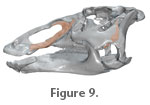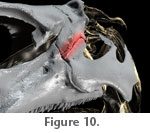| |
RESULTS
 The preliminary model presented here attempted to replicate the primary movements (Figure 9) described in the original pleurokinetic model of chewing in hadrosaurid dinosaurs (Weishampel 1984) (see
Figure 3). The original model, based on Corythosaurus, described intracranial movements during the powerstroke phase of the chewing cycle. A comparison of the primary movements (i.e. maxillary, quadrate, and mandibular movements) in the two models is shown in
Table 1. In the presented animation model (Figure 8), the mandible protracted approximately 4.1 cm. The maxilla abducted 2.1 cm. The jaw joint retracted and abducted approximately 2.1 cm. In lateral view, the degree of rotation of the mandible (with respect to the quadrate) in both models is the same, and the rotation of the quadrate, leading to mandibular retraction, is also similar. The abduction of the quadrate and maxilla are the same in Edmontosaurus (3°) because they were linked (see
Methods: 3-D animation). The Edmontosaurus and Corythosaurus models differ dramatically in the degree to which the maxillae abduct. In Corythosaurus the maxillary rotation (abduction) is 10° and the quadrate is only 7°. In The preliminary model presented here attempted to replicate the primary movements (Figure 9) described in the original pleurokinetic model of chewing in hadrosaurid dinosaurs (Weishampel 1984) (see
Figure 3). The original model, based on Corythosaurus, described intracranial movements during the powerstroke phase of the chewing cycle. A comparison of the primary movements (i.e. maxillary, quadrate, and mandibular movements) in the two models is shown in
Table 1. In the presented animation model (Figure 8), the mandible protracted approximately 4.1 cm. The maxilla abducted 2.1 cm. The jaw joint retracted and abducted approximately 2.1 cm. In lateral view, the degree of rotation of the mandible (with respect to the quadrate) in both models is the same, and the rotation of the quadrate, leading to mandibular retraction, is also similar. The abduction of the quadrate and maxilla are the same in Edmontosaurus (3°) because they were linked (see
Methods: 3-D animation). The Edmontosaurus and Corythosaurus models differ dramatically in the degree to which the maxillae abduct. In Corythosaurus the maxillary rotation (abduction) is 10° and the quadrate is only 7°. In
 the Edmontosaurus model the maxillary and quadrate movements were linked, and 3° of movement sufficed to allow the upper and lower teeth to complete the powerstroke. the Edmontosaurus model the maxillary and quadrate movements were linked, and 3° of movement sufficed to allow the upper and lower teeth to complete the powerstroke.
To accommodate the primary movements, secondary movements were required (Figure
10) at the pterygoid-palatine, pterygoid-ectopterygoid-maxilla, pterygoid-quadrate, pterygoid-basisphenoid, and jugal-quadratojugal contacts. In some cases these movements involved marked separation of the elements. For example, during the chewing cycle, the jugal and quadratojugal were separated 1.3 cm, and the separation between the ventral portion of the pterygoid and the quadrate was approximately 1.4 cm.
|

